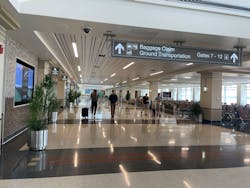Dane County Expands More Than Its Gate Capacity

Dane County Regional Airport (MSN) recently opened a brand new south terminal expansion. Prior to the COVID-19 pandemic, the airport set all-time records for passenger volume three years in a row. Airport officials quickly realizing they would soon run out of gate space, started having conversations about expanding the terminal.
The 90,000-square-foot terminal opened in the beginning of June 2023. Currently, three of the six new gates are operational as the airport continues to work through the demolition and re-pavement of the old wing.
The expansion project not only tackled gate capacity issues, but also alleviated challenges with the original design of the building.
Dane County Regional Airport Director of Marketing Communications Michael Riechers said the previous gate design created a chokehold for aircraft.
“The last three gates at the southern end of the airport sloped down to ground level. And while the rest of our building is oriented north-south, the last three gates took a turn and actually was oriented more towards the airfield. So, it created a little bit of a bend in the building, which then created a parking challenge for some larger, more modern aircraft. And it created a choke point where we couldn't fit two large modern aircraft next to each other between gates 10 and 11,” Riechers said. “So, with the new expansion and the expansion to the airport, the entire building is oriented north-south. So, it eliminated those old three gates. So, all of the planes park next to each other instead of angled tail to tail in some of the old parking areas.”
The airport worked with engineer and architecture firm Mead & Hunt and general contractor Myron Construction for this project.
Improved Passenger Amenities
Riechers said the airport put a lot of focus on accessibility with the new terminal.
“Chief among those accessibility items would be the caregiver bathroom that we have, which was deliberately built much larger than it needed to be, so that not only could a wheelchair and an attendant fit in there, but up to two or three caregivers could all be in there with the traveler,” Riechers said. “We have a changing table for adults with a 500-pound capacity, so adults with special needs that might need special assistance, there's plenty of space and comfort there for them to do what they need to do.”
Other accessibility features throughout the airport include “wave to open” technology located at many doors leading to restrooms and meeting spaces and the installation of rerrazzo flooring. Terrazzo was installed throughout the terminal to make it easier for travelers to roll their carry-on luggage, wheelchair, or stroller.
Like the caregiver bathroom, Riechers said the service animal relief area was also built “quite a bit bigger than it needs to be” with a lot of hygienic and user-friendly details.
“So, the floor is raised, and it's AstroTurf. Below that floor, it's completely sealed. It's an epoxy flooring. So, there's a hose in the room, so when the dog is done doing its business, you can just hose it down. It's super clean and easy to use. And if the handler or owner forgets to do that, the room actually flushes itself,” Riechers said. “If it goes 15 minutes without detecting motion, the epoxy flooring is flushed with our system automatically, and ideally just makes it nice, and clean, and safe for everyone to use.”
Within the animal relief area both trash receptacles feature suction from the HVAC system.
“It's constantly pulling air out of the trash cans, so any foul odor or anything from the trash cans gets sucked up as part of the HVAC system and vented out of the building.”
Mead & Hunt Project Architect Jeff Manzetti said, “We kind of took it up a notch on just how to maintain it and how to make it a pleasant space because everyone that we looked at or toured was just this really kind of cramped and really had a smell to it.”
Continuing the theme of large accessibility areas, the mother’s lounge was also built with the same principle in mind.
“We provided a lot more space than what's commonly seen in commercial airports,” Riechers said. “We wanted to make it comfortable, and safe, and inviting for mothers that are nursing and traveling because we understand that can be very, very challenging. So, there's plenty of space there.”
Within the lounge there are two sinks, one specifically for bottle cleaning, an enclosed bathroom, a microwave, refrigerator, table changing space and seating.
Just outside of the mother’s lounge is the children’s play area full of sensory experiences including colorful furniture that can be moved and transformed, colorful lights and a projector that provides interactive games and stimulation.
Riechers said there are still a few ongoing projects throughout the terminal.
“We have space available for our food and retail vendors to complete work in their areas,” Riechers said. “We have a bar that's built out, that's almost ready to serve passengers. So, waiting on a few additional details, of course, with construction and staffing shortages. Those delays happen. But we're excited to have those open.”
A Focus on Staff Needs
One of the more unique aspects of the new terminal is the large amount of space dedicated to the staff. The expansion is 90,000 square feet, 45,000 square feet of that is the gate area upstairs and the remaining 45,000 square feet is dedicated to airport infrastructure, workspace, workshops, and break rooms located downstairs.
“We invested heavily into the comfort, and convenience, and capability of our staff, particularly our maintenance and custodial staff, because they do a lot around the airport,” Riechers said. “They quite literally keep the lights on for us.”
Riechers continued, “An air airport our size actually has a lot going on. It's a big facility and it takes a lot to keep everything running. Just on our staff, we have electricians, we have plumbers, we have pipe fitters, and steam fitters, HVAC technicians, as well as, of course, the whole custodial staff. And all of the equipment that our custodial staff and other trades use, a lot of that we service in house. So, what that does for us means when something does break, something does go down, and of course it's inevitable for a facility our size, our own staff is able to fix it with the tools, and parts, and pieces that we have on hand. So, at any given time, if something goes down, generally we're able to get it back online, the disruption to our traveling public is minimal, and really makes it more efficient for the airport.”
Manzetti said from his experience working on projects like this one, the space dedicated for the staff is unique.
“This is unique. Before this project I worked in Detroit. And it's a whole different animal, but they have their own building for that kind of stuff. So, these regional airports or kind of this size of airport to put it within the building is kind of unique,” Manzetti said. “There was a lot of user meetings and I thought they came up with some really great ideas that we incorporated. So, it's very unique. So yeah, it's not common.”
Frank Lloyd Wright Prairie Style Design
“Frank Lloyd Wright and this prairie style that came through in the original design the Architectural Alliance did in the 2000s, about. That was when they started to try to put a theme or kind of design to the airport,” Manzetti said. “They did two big projects in ticketing and then one in the concourse and expanded it. And during that time, it was a nod to that prairie style, kind of linear and geometrical. … I think it's kind of a unique identifier for them. And so, we tried to take what they had in that existing building and project it through into the new expansion.”
The south end of the terminal has a hidden gem that can be found within the terrazzo flooring.
Next to large windows with a view of the airfield and lounge seating, a map of the local lakes can be found in various shades of blue within the terrazzo. In addition to the lakes, an overheard view of the runways can also be found within the flooring.
Passenger Amenities Can Make Your Airport Standout
Manzetti said one of his favorite parts in working on this project was the accessibility elements, especially in the restrooms.
“I think this project here, we tried to look at it more to say, ‘Hey, there's these passengers, whoever they are, are coming with bags, everybody is going to have a bag.’ So, we want to give a little bit more space in those restrooms. So, we have extra-long stalls. And then try to accommodate, but not be too in your face to people who don't have families. So, accommodate the family with child seating. In each stall there should be at least one child seat [that folds down from the wall]. And then also there's some stalls where if you have two kids or even more that you can use the stall without having your kids all over the place, especially in a bathroom, so some stalls have two seats.”
Manzetti said it’s the kind of thoughtfulness that went into the restroom designs that can make a big difference in passenger experience and highly encourages other airports to consider these accommodations in their projects.
“I know it's not every project where you got an owner that is willing to do those kinds of things because the more space you got, the more money it costs. But if you can do it, look at your restrooms and really think about the space that's kind of needed for those things,” Manzetti said.
About the Author
Christina Marsh
Editor
Christina Marsh (Basken) is a passionate aviation enthusiast and sport pilot with industry knowledge and experience in writing and editing for digital and print publications as well as creative content in photography, videography, and podcasting.
Christina graduated from the University of Wisconsin-Oshkosh with a bachelor’s degree in journalism with a visual emphasis.
